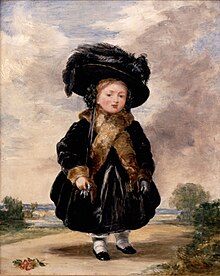
The Kensington System was a strict and elaborate set of rules designed by Victoria, Duchess of Kent, along with her attendant and supposed lover, Sir John Conroy, concerning the upbringing of the Duchess's daughter, the future Queen Victoria. It is named after Kensington Palace, where Victoria resided with her mother prior to acceding the throne.
Application edit
The System was aimed at rendering the young Princess Victoria weak and dependent, and thus unlikely to adhere to her other relatives in the House of Hanover against her mother and Conroy. Young Victoria was never allowed to be apart from either her mother, her tutor, or her governesses, Baroness Lehzen and the Duchess of Northumberland. She was kept isolated from other children; her mother and Conroy strictly monitored and recorded her every action and entirely controlled whom she was allowed to meet.[1] When it became clear that Victoria would inherit the throne, they tried to induce Victoria to appoint Conroy her personal secretary and treasurer via a long series of threats and browbeating, to no avail.
Endorsement edit
The system was endorsed by Queen Victoria's half-brother, Carl, 3rd Prince of Leiningen, who supported his mother's ambitions for a regency. In 1841, after Victoria had become queen and made her displeasure with the Kensington System known, Carl even published a book to justify it, entitled A Complete History of the Policy Followed at Kensington, Under Sir John Conroy's Guidance.[2]
Victoria's response edit
The Kensington System was an utter failure and backfired spectacularly: Victoria grew to hate her mother, Conroy, and her mother's lady-in-waiting, Lady Flora Hastings, over the system. Her first two requests, upon her majority, were that she should be allowed an hour by herself (which the Kensington System had never permitted) and that her bed should be removed from her mother's room (which presaged the cessation of her mother's influence, and, through her mother, of Conroy's).[3] Among Victoria's first acts upon her accession to the throne at the age of 18 was to ban Conroy from her apartments permanently.
After a brief engagement, Victoria married Prince Albert in 1840, and thus was no longer conventionally required to live with her mother. At the conclusion of her wedding ceremony, she only shook hands with the Duchess. She soon thereafter evicted her mother from the palace and rarely visited her, remaining cold and distant from her until the birth of her first child.
Other uses edit
The term also sometimes refers to what is more commonly called the South Kensington system, an unrelated syllabus for teaching art developed at what is now the Royal College of Art in London during Victoria's reign.
References edit
- ^ Lacey, Robert (2006). Great Tales from English History, Volume 3. London: Little, Brown, and Company. pp. 133–136. ISBN 0-316-11459-6.
- ^ Rappaport, Helen (2003). Queen Victoria: A Biographical Companion. ABC-CLIO. pp. 218–220. ISBN 1-85109-355-9.
- ^ "BBC History Magazine". October 2009.
{{cite news}}:|first=missing|last=(help); Cite has empty unknown parameter:|coauthors=(help)
External links edit
- "Queen Victoria: the original people's princess" (14 September 2008) The Daily Telegraph
